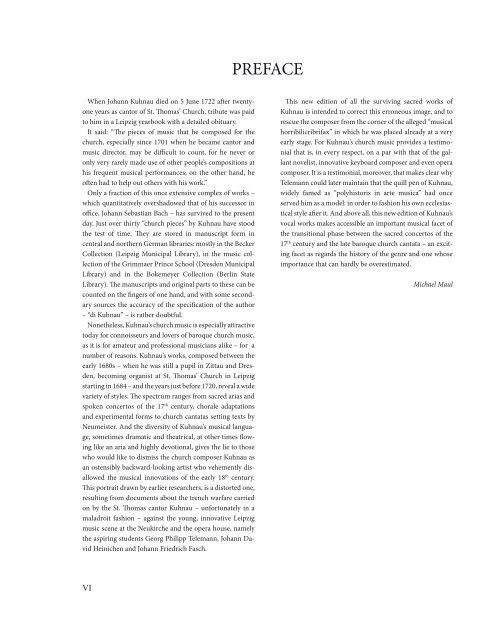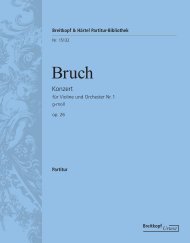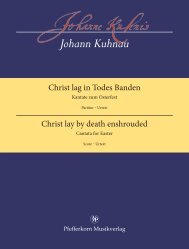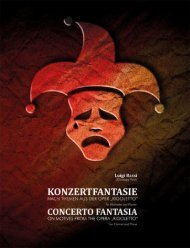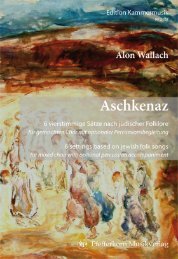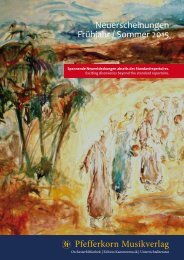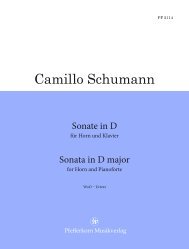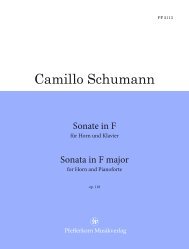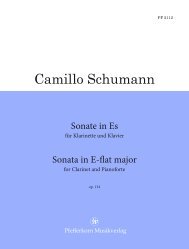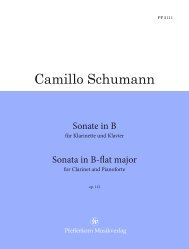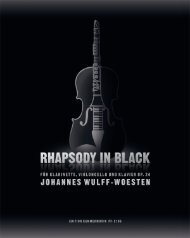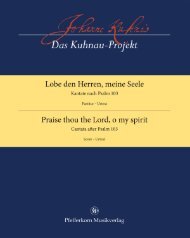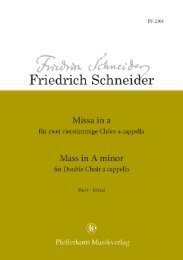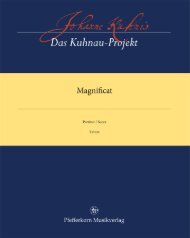Gott, der Vater, wohn uns bei
PF-2029 Johann Kuhnau: Gott, der Vater, wohn uns bei, Kantate zum Trinitatisfest
PF-2029 Johann Kuhnau: Gott, der Vater, wohn uns bei, Kantate zum Trinitatisfest
- Keine Tags gefunden...
Erfolgreiche ePaper selbst erstellen
Machen Sie aus Ihren PDF Publikationen ein blätterbares Flipbook mit unserer einzigartigen Google optimierten e-Paper Software.
PREFACE<br />
When Johann Kuhnau died on 5 June 1722 after twentyone<br />
years as cantor of St. Thomas’ Church, tribute was paid<br />
to him in a Leipzig yearbook with a detailed obituary.<br />
It said: “The pieces of music that he composed for the<br />
church, especially since 1701 when he became cantor and<br />
music director, may be difficult to count, for he never or<br />
only very rarely made use of other people’s compositions at<br />
his frequent musical performances; on the other hand, he<br />
often had to help out others with his work.”<br />
Only a fraction of this once extensive complex of works –<br />
which quantitatively overshadowed that of his successor in<br />
office, Johann Sebastian Bach – has survived to the present<br />
day. Just over thirty “church pieces” by Kuhnau have stood<br />
the test of time. They are stored in manuscript form in<br />
central and northern German libraries: mostly in the Becker<br />
Collection (Leipzig Municipal Library), in the music collection<br />
of the Grimmaer Prince School (Dresden Municipal<br />
Library) and in the Bokemeyer Collection (Berlin State<br />
Library). The manuscripts and original parts to these can be<br />
counted on the fingers of one hand, and with some secondary<br />
sources the accuracy of the specification of the author<br />
– “di Kuhnau” – is rather doubtful.<br />
Nonetheless, Kuhnau’s church music is especially attractive<br />
today for connoisseurs and lovers of baroque church music,<br />
as it is for amateur and professional musicians alike – for a<br />
number of reasons. Kuhnau’s works, composed between the<br />
early 1680s – when he was still a pupil in Zittau and Dresden,<br />
becoming organist at St. Thomas’ Church in Leipzig<br />
starting in 1684 – and the years just before 1720, reveal a wide<br />
variety of styles. The spectrum ranges from sacred arias and<br />
spoken concertos of the 17 th century, chorale adaptations<br />
and experimental forms to church cantatas setting texts by<br />
Neumeister. And the diversity of Kuhnau’s musical language,<br />
sometimes dramatic and theatrical, at other times flowing<br />
like an aria and highly devotional, gives the lie to those<br />
who would like to dismiss the church composer Kuhnau as<br />
an ostensibly backward-looking artist who vehemently disallowed<br />
the musical innovations of the early 18 th century.<br />
This portrait drawn by earlier researchers, is a distorted one,<br />
resulting from documents about the trench warfare carried<br />
on by the St. Thomas cantor Kuhnau – unfortunately in a<br />
maladroit fashion – against the young, innovative Leipzig<br />
music scene at the Neukirche and the opera house, namely<br />
the aspiring students Georg Philipp Telemann, Johann David<br />
Heinichen and Johann Friedrich Fasch.<br />
This new edition of all the surviving sacred works of<br />
Kuhnau is intended to correct this erroneous image, and to<br />
rescue the composer from the corner of the alleged “musical<br />
horribilicribrifax” in which he was placed already at a very<br />
early stage. For Kuhnau’s church music provides a testimonial<br />
that is, in every respect, on a par with that of the gallant<br />
novelist, innovative keyboard composer and even opera<br />
composer. It is a testimonial, moreover, that makes clear why<br />
Telemann could later maintain that the quill pen of Kuhnau,<br />
widely famed as “polyhistoris in arte musica” had once<br />
served him as a model: in or<strong>der</strong> to fashion his own ecclesiastical<br />
style after it. And above all, this new edition of Kuhnau’s<br />
vocal works makes accessible an important musical facet of<br />
the transitional phase between the sacred concertos of the<br />
17 th century and the late baroque church cantata – an exciting<br />
facet as regards the history of the genre and one whose<br />
importance that can hardly be overestimated.<br />
Michael Maul<br />
VI


